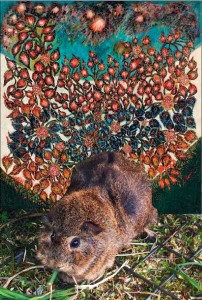
My photo of Kirsty’s guinea pig mashed up with Seraphine Louis’ L’Arbre de vie. Oil on canvas (114×145 cm), 1928. Musée d’Art et d’Archéologie de
Senlis, France. © Musée d’Art et d’Archéologie de Senlis; Christian Schryve, Compiègne; © ADAGP. Retrieved from http://www.medicographia.com/2010/10/art-and-psychosis/ on 9/3/13.
Séraphine de Senlis reminds me of Des, the blind synesthesic guinea pig. They are of a feather. Neither has feathers, of course. Séraphine wears an old crocheted shawl and Des has infinitely soft fur. Séraphine was a real person; Des is only imaginary. Both have a life on the Internet. So, who are these creatures?
Séraphine de Senlis was an early 20th century French painter, an uneducated, working class orphan who grew up in a convent. She had a passion for painting as strong as a Labrador’s passion for water or a Kelpie’s passion for rounding up sheep. According to the beautiful movie about her life that I saw on SBS TV last night, she made pigments out of animal blood, roadside weeds and stolen church wax. She worked all night, ardently, on her paintings. During the day she was a cleaner, mopping the floors of bourgeois families; the sort of person who is of invisible service. Her talent was discovered by a German art collector and suddenly she was someone of note. It all ended in tears at a madhouse. For me the most moving scenes were the stealing of the animal blood (from a big pot in a butcher’s shop), the decanting of church wax from lit candles, the grabbing at weeds. All this work and experimentation was carried out alone, on the floor of her tiny apartment. As she neared the end of a painting she’d start singing. It was a humble life, full of art and ecstasy.
I started watching this movie accidentally. I was washing up, making a lot of noise. I was half-glancing at the screen, noticing that it was a French movie, beautiful cinematography. I started standing behind the sofa to watch it, tea-towel in hand. Then I moved around to sit in the sofa properly, and committed. The blessed relief in watching a movie about a woman who was neither young nor beautiful, holding centre stage, scene after scene. And not in a patronising, comic, overdetermined, Educating Rita sort of way. This was a movie prepared to look at this woman from inside. That in itself was wondrous. And then to see she was an artist, grinding her pigments with a mortar and pestle, dabbing paint on her board with her fingers, lying down to sleep with her paintings … even better. It suddenly made the last film I loved – Ang Lee’s Life of Pi – plummet down the floors like a broken lift.
Séraphine also made me think of Félicité, the servant who loved a parrot in Flaubert’s A Simple Heart. Again, the outward image of a “nobody”; the rich interior life.
And so we come to Des, the blind synesthesic guinea pig. Who is he? Just a guinea pig in a hutch in someone’s back yard. The hutch is moved from place to place in the back yard. He munches through grass like any other guinea pig. Nobody even realises that he is blind; his blindness doesn’t stop him performing any of his normal pet guinea pig functions. Like Séraphine and Félicité, he has a rich, ecstatic inner life. As a synesthete, he hears colours and feels sounds. He has deep wisdom about the world beyond the hutch but no particular need or desire to move beyond it. He is happy to be picked up and cuddled – an explosion of colour, sound and sensation – and happy to munch on grass. He can taste music in the grass. (No, not that sort of grass. This is buffalo grass, mixed with couch and clover and the odd dandelion.)
I got to know Des by tweeting about him. I’d been playing the competitive Twitter word of the day game on Artwiculate for some time, when he quietly appeared in one of my tweets. This has happened to other Artwiculate players: a character arises spontaneously out of their tweets and demands to be included, here and there, in other tweets down the line. The Des tweets were automatically indexed by the Artwiculate site so from time to time I could go back and look at them, like opening a book on a shelf. Then disaster struck, in the form of a resentful hacker (someone who wasn’t winning as often as he thought he should). Mortally wounded, Artwiculate was put into an induced coma. When it came out of this coma, its archive – and the voting system itself – had been removed. All gone. It was as if Des had never existed. It’s true that I could search back on my own Twitter timeline but this wasn’t quite the same as being indexed by Artwiculate. (Only a veteran Artwiculate player can understand the emotional importance of being indexed.) This would not bother Des in the slightest, but it was bothering me. I tried to be philosophical about it (as did other Artwiculate players, many of whom realised they were grieving out all proportion) and remind myself that Twitter is just a branch on a tree with birds on it. These birds might fly at any time. The whole branch might come down in the next storm. It’s a babbling (sometimes shrieking) brook into which you can’t dip your toe twice; it’s a shaft of light moving across a room. This desire to archive, to pin things down, violates the very nature of Twitter and even of Artwiculate itself.
Still.
This morning, as I was thinking about Séraphine, Félicité and Des, it occurred to me to Google him. Perhaps it’s really true, this thing we tell high school students – if you put something on the Internet, it never goes away. I entered “Des, the blind synesthesic guinea pig” and there he was. A whole page! A page of references that were just about Des, the Des of Artwiculate. Des de Artwiculate. Seraphine de Senlis. Félicité du perroquet. Here’s the screen grab:
